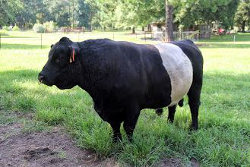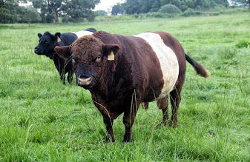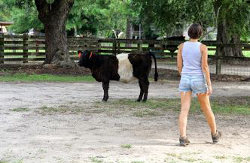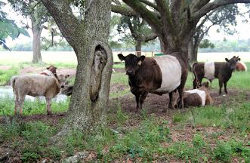PrinciplesGrass FarmingOur cattle do the work of aeration, fertilization, and pasture management through intensive rotational grazing... Sustainable Preserving Heritage Breeds Belted Galloways aka Oreo Cows from proven time tested genetic lineage... Health the most nutritious, hormone free, antibiotic free, pesticide & herbicide free beef... Ecologically Sound We are the stewards of the land and our animals and respect and tend to their needs.. NO
YES
|
OUR CATTLEHistory:Belted Galloways, also known as "Oreo Cows" originated in the hill country of southwestern Scotland as Galloways (no belt). The grazing animals of this region had to be hardy, thrifty, animals to endure the sparce foraging of the rocky land and the harsh winters. In the late 1700s and early 1800s the breed was refined by selective breeding to arrive at polled (no horns) cattle that retained their adaptive qualities. The herdbook for Galloways was established in 1877. There is no consensus on where belted color pattern came from. The belted pattern occurs in other heritage breeds such as the Lakenvelder in the Netherlands - also called the Dutch Belted in the U.S. which may share a common ancestry with the Belties. A separate herd book for belted cattle was established in Scotland in 1928 which led to the formation of the Belted Galloway breed. The first Belties were imported to the U.S. in the 1930's and current U.S. registrations number around 8,000. The Belted Galloway is also gaining popularity in Canada and Australia. Although they are not endangered, they are a true heritage breed. Qualities: After managing other breeds of cattle Keith Jones of Driftwood Plantation started with Belties and thought how could these smallish animals compete with the large cattle breeds. Then after a few years he became a true believer that this breed can hold its own with any other breed - and Keith has proved that! Disposition: After having visited other cattle breed farms and seeing huge angry animals chase the handlers up on to the fence panels, we wanted to have more manageable cattle..When we first talked to Keith about getting some cattle he told us to FIRST look for a good disposition. "One bad dispositioned animal will take up 90% of your time and effort." We have followed Keith's advice. Belties are known for being gentle, compliant, easy going cattle. We routinely work around them and they calmly watch us, mingle, and keep a respectful distance. The mama cows show a strong maternal instinct to protect calves against predators. Size: Although Belties considered a medium size breed they are compact, long, and short legged - making for an excellent producer often yielding more than 60% usable body weight as beef. Cows weigh about 1,000 lbs. and bulls about 1,600 lbs. One of the benefits that we saw with their size is the Beltie's ability to birth calves without our intervention. It is quite common to hear of other breeds using Beltie bulls to sire offspring to gain the benefits of easy birthing. Color: Black & White, Red & White, Dun & White. Occasionally there are pigment variations that produce a very light brown and white that almost look like a white cow. Coat: The standard coat is shaggy in the winter and shed in the summer. Their thicker coat means that they do not have to produce as much fat to stay warm in the colder months therefore producing a lean beef. Their distinctive hides are highly desired for rugs and hangings. The Beltie cross breedings tend to produce a Beltie with a smooth coat that often retains the belted look. Utility: Belties are known as "light-grazers", their lighter mass protecting the soil from over compaction. They also are considered "browsers" and will eat a variety of forages - grass and weeds - which make them an excellent choice for organic grass fed beef. As well as good choice for beef, Belties are used for milk production and are shown internationally in conformation competitions, many sponsored by the U.S. Belted Galloway Society. Nutrition: In late 2008, the Belted Galloway Society Foundation (BGSF) funded a study of the nutritional value of selected cuts of Belted Galloway beef. These data show the remarkable differences between Belted Galloway beef as compared with reference beef. On average the beef of the Belted Galloway is 46% lower in calories, 72% lower in fat calories, 68% lower in total fat, 69% lower in saturated fat, 57% lower in cholesterol, 19% higher in protein, 67% higher in calcium, 73% higher in niacin, more stearic acid, less oleic acid, much more linolenic and conjugated linoleic acids and a markedly lower n-6/n-3 ratio. | Links Belted Galloway Beef is Nutritional! In late 2008, the Belted Galloway Society Foundation (BGSF) funded a study of the nutritional value of selected cuts of Belted Galloway beef. . These data show the remarkable differences between Belted Galloway beef as compared with reference beef. The Cattle Site History, characteristics, comparisons...  SVF Foundation SVF Foundation preserves germplasm (semen and embryos) from rare and endangered breeds of food and fiber livestock.  Nutritional Study Photos  Otto - Example of a Black & White Beltie Bull  Talon - Red & White Bull  Mama cow - maternal instincts  Working with a calf, this shows the easy disposition of even the young steers  |